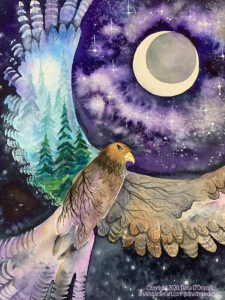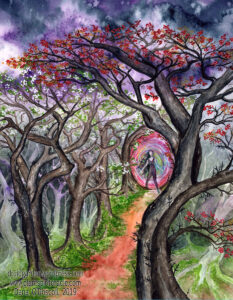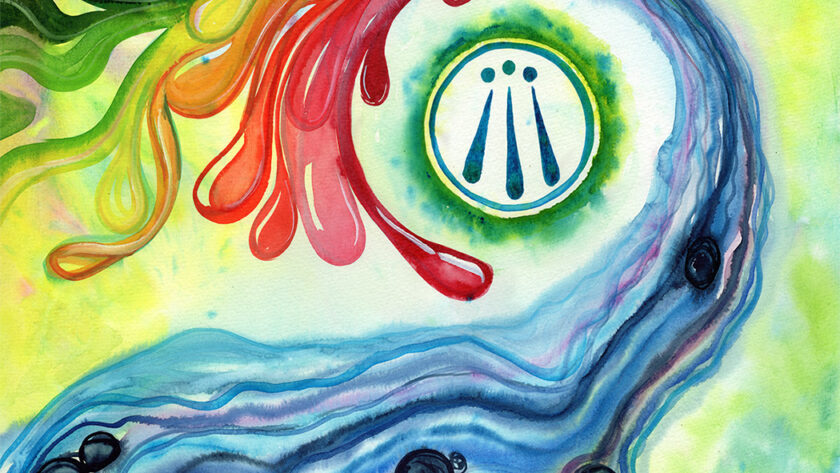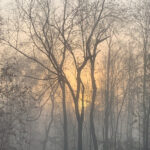What do Salvador Dali’s Persistence of Memory (the painting with the melting clocks), Elias Howe’s invention of the lockstitch sewing machine in 1845, and the Beatles’ song Yesterday, have in common? They all were ideas that first emerged in dreams. Dreams, where we spend up to 1/3 of our lives, are fertile soil for us to explore and expand our creative practices.
Dreaming is recognized by researchers[1] to be a place where we can have a much more creative space of mind because we are not bound by external input nor our own self-imposed limitations—the mind is literally able to go anywhere, do anything, and be anything. Daydreaming in many ways mimics more deep sleep dreaming, where the mind is again free to wander, to create, to explore. Because of this, both daydreaming and dreaming are powerful creative tools, and one you can harness to build your creative practices, generate ideas, and create a more fanciful view of the world.

Just so you know, I’m going to continue to write about how to foster bardic arts and creativity in your life due to the new challenges present with Artificial Intelligence successfully replacing human creations. I feel like it is a really important time to speak to the value and importance of human creativity, how to foster creativity, and how to make creative practices accessible to all people. Some of you may remember that I was OBOD’s 19th Mount Hameus scholar, where my research explored the role of the bardic arts in the druid tradition, and I’m continuing to explore these themes with new research and work in these areas. Previous posts in this series include taking up the path of the bard parts I, and II, practice makes perfect, the fine art of making things, bardic arts as spiritual development, rituals to enhance creativity, cultivating the flow of awen in our lives, the bardic arts and the ancestors, visioning the future with the bardic arts, and creativity to support mental health. So let’s continue our journey in exploring the bardic arts as a core part of spiritual practice and being human with–daydreaming!
This post specifically explores the practice of daydreaming to cultivate creative thoughts and ideas, and in two weeks, my post will explore dreaming, including dream recall and lucid dreaming. There’s actually a great deal of published research on these topics, which is pretty cool! So let’s dive in!
Daydreaming and the Spark of Creativity / Awen
Daydreaming is most often described as mind-wandering or focused thought that is not directly related to the present. In other words, your thoughts stray from the task at hand or the present, and you have thoughts and experiences that take you somewhere else–you envision conversations, you have fantastical experiences, or think about completely other things–all while being awake. Daydreaming is something that humans all do, but of course, our productivity-focused, insane industrial culture discourages such activity and frames it in a negative light.
Daydreaming can take you into fantastical worlds in your imagination and can be rich and fertile soil for creative ideas to emerge. We can think up fantastical tales, consider the steps through which to engage in a new project or even journey deeper into our own imaginal realms. What isn’t in the literature, of course, is that there can be little difference between what the experts would call daydreaming and what a druid might recognize as journeying on the inner planes. More on that later.
Despite these cultural inhibitions, daydreaming has a considerable scientific body of evidence to show that it fosters and stimulates creativity. For example, if you are stuck on a particular problem, one of the best things to do is take a break from the problem, do some mundane activity (walking, sitting, being in nature), and allow the mind to wander and daydream for a time, to let your subconscious work out the problem. By stepping away from “productive” work, you are more likely to generate the kinds of creative ideas necessary to solve the problem at hand[2]. This principle doesn’t just apply to people who are engaged in creative acts (like creative writers) but also to those who are trying to solve pressing professional problems (like physicists). Thus, by not paying attention for a while, you allow your subconscious to come up with ideas. This works not only over a short period of time but a longer one–you can set aside a problem you are not making headway on and allow it to rest for a while and ideas will often come to you.
Research also shows that some people have a tendency to daydream more than others—those who do have more creativity[3] and may have more spontaneous ideas and insights (Druid translation = Spark of Awen!) [4]. I wonder about this research–is it a “tendency” as researchers claim, or maybe it’s just allowing yourself the time to get lost in other places and cultivate a rich inner life. More on that is below.
Fantastical Daydreaming
Different kinds of daydreaming exist, and some types of daydreams generate more creative ideas than others. Researchers have found that many daydreams may be about mundane life, e.g. you are thinking about “what ifs” in mundane life or working to solve upcoming problems in daily life, or they are sexual in nature. So basically, these kinds of daydreams extend mundane life. These mundane daydreams are not associated with higher levels of creativity activity or ideas. Those are just you working through various issues or having some fantasy time in your mind.

Two kinds of daydreams are particularly linked with creativity – those that are “fantastical” and those that are “personally meaningful.”[5] Fantastical daydreams are as the word suggests—they are otherworldly, supernatural, weird or somehow outside of mundane reality. In druid terms, it sounds like fantastical daydreams are all about cultivating a rich inner life: they are the places we may journey to in our inner worlds, the spirits we encounter, and the beautiful landscape of our inner spiritual life.
The other kind of daydream that is linked with higher creativity is a meaningful daydream. Meaningful daydreams are those of increased personal significance or value to an individual. Individuals who engage in these two kinds of daydreams are those that have higher creativity and generate more novel ideas.
This research makes a lot of sense—while creativity itself is often defined in multiple ways, one of the core ways it is always defined in this research is the ability to come up with novel and useful ideas or uncommon approaches to solve problems. That is, it is all about linking things not commonly linked together or seeing novel ways of doing something. Other definitions include unique and meaningful personal expressions and art–but all of these different facets of creativity are supported by this body of work.
The Boundaries Between Daydreaming and Spirit Worlds
Since I’m a well-published learning researcher and a druid, I understand the kinds of limitations of these studies–what can and can’t be said. Modern researchers can’t or won’t acknowledge that spirit worlds exist, there’s no way to know how many of these fantastical, meaningful daydreams are actually interactions with spirits, inner planes, and spirit worlds. One would assume that at least some of these are, even if the participants and researchers don’t use those terms.
So I’ll step into my own experience to fill in this space. I do think there’s what I would call intentional spirit journeying, for example, going to an inner grove or safe space, interacting with spirits and guides, or going on other kinds of spiritual journeying. These are intentional deep meditative spaces where you are engaging in these as a spiritual practice. For most people, we work to have these experiences–setting up safe and sacred spaces, setting aside time, and making spiritual intentions. Is that the same as daydreaming? Not really, but I would be it gives us the same result.
But there’s also daydreaming that is much less intentional and maybe happens in different times and places. Your mind wanders for 10 minutes while looking at the sky. You make up a fantasy world in your head that you like to return to. This can be more whimsical and fantastical–perhaps a story you are writing in your head, diving into a photograph to see where it leads, or other less formal things. Are these part of your inner world? Sure.
The difference here seems to be in intention. When I go intentionally into the inner planes, I have committed to that journey and maybe I have specific goals or things I want to accomplish. When I lay by the stream and daydream for 10 min, I don’t have such a strong intentional goal. The daydream goes where it wants to go, just like a little puff of milkweed fluff carrying a seed into the wind. Both of these are useful and in my experience, both can offer creative inspiration. (For example, my 48 card Plant Spirit Oracle was painted as part of a set of intentional inner journeys while I worked through the Celtic Golden Dawn pathworkings).
Fostering Daydreaming in Your life: Activities and Approaches

Knowing that there are different kinds of daydreams and that more fantastical and meaningful daydreams foster creativity, we can support our creative practice by intentionally creating space for daydreaming. People often daydream without realizing it, but we can be intentional in making this a habituated practice.
So the first thing to do is allow yourself permission to daydream. See it as an investment in your creative path, in cultivating the flow of Awen in your life, and in developing your bardic skills. Recognize that if you commit to doing anything and do it regularly, it will come more easily and naturally to you. So just give yourself permission to enjoy the practice of daydreaming without the slog of modern-day expectations.
Then: create space to daydream. This is less formal than meditation or spirit journeying, it’s really just a free space for the mind to rest and wander, for the subconscious to rise to the surface, and to see what happens. At least once a day, find a spot where you are comfortable, and simply lay down and allow the mind to wander. Lay in bed, sit on the grass, drink some tea, or sit by the steam and daydream. For a time, allow the mind to meander. Don’t have a purpose Think about fantastical things, other worlds, perhaps even places you’ve visited before. Create narratives of people and ideas in your head. See what happens.
Even a short amount of daydreaming each day can help more generally foster your creativity and allow the awen to flow!
Announcement: The Sacred Actions Journal
I’m happy to be back from my blogging hiatus and have a few things to share. First, if you haven’t yet had a chance to preorder my Sacred Actions Journal, please consider doing so! It will be released on January 24th and next week’s post will be about it and the sacred journaling course I’ve been developing. This is a compliment to my Sacred Actions: Living the Wheel of the Year through Earth-Centered Spiritual Practices book. You can preorder it here:
Directly from the Publisher (USA/International)
Thank you so much for supporting my work and reading. Blessings of the flowing maples to you.
References
[1] Stumbrys, Tadas, and Viktorija Daunytė. “Visiting the land of dream muses: The relationship between lucid dreaming and creativity.” International Journal of Dream Research 11, no. 2 (2018): 207-212.
[2] Gable, Shelly L., Elizabeth A. Hopper, and Jonathan W. Schooler. “When the muses strike: Creative ideas of physicists and writers routinely occur during mind wandering.” Psychological science 30, no. 3 (2019): 396-404.
[3] Baird, Benjamin, Jonathan Smallwood, Michael D. Mrazek, Julia WY Kam, Michael S. Franklin, and Jonathan W. Schooler. “Inspired by distraction: Mind wandering facilitates creative incubation.” Psychological science 23, no. 10 (2012): 1117-1122.
[4] Zedelius, Claire M., and Jonathan W. Schooler. “Mind wandering “Ahas” versus mindful reasoning: Alternative routes to creative solutions.” Frontiers in Psychology 6 (2015): 834.
[5] Zedelius, Claire M., John Protzko, James M. Broadway, and Jonathan W. Schooler. “What types of daydreaming predict creativity? Laboratory and experience sampling evidence.” Psychology of Aesthetics, Creativity, and the Arts 15, no. 4 (2021): 596.




I am constantly amazed by your daily output of fulsome posts. I wonder how you are able to do this every day without burning out. But this post hints at why this is possible. You are a dream writer. The text flows out of you like a daydream. Well… Not exactly but there is definitely a flow. Nature provides a wonderful illustration of this flow through the phenomenon of aurora borealis. Interestingly enough, for those of us who discern human auras, the movement and flow is almost identical. It is also very much the constant flow of ideas -or “monkey mind” as some Buddhists call it. In fact all of the etheric, astral and other layers of LIFE are in constant motion like this. How do we orient our selves in this constantly moving and changing cosmos? Through engagement in the living practice of unconditional love – caressing all beings we encounter with our light. I have a hunch this is essential for creative work of any kind because through this process we learn to discern the difference between dead leaves (thoughts) that are blowing around and green ones (ideas) that are generating life.
Hi Kymbriel,
Thanks for your thoughts! Its a combination of habituated writing practice (I write for the blog and my druid books for two 3 hour writing sessions a week, typically) and also getting into the flow state. And working to see inspiration in the world. I do take a hiatus twice a year from blogging and writing to “recharge” the batteries so to speak! But writing is something that I really enjoy and it definitely is a kind of meditation for me. So yeah, for sure!
And yes, I love what you are saying here about the etheric and astral layers. I really feel like that’s part of this entire daydreaming/creative flow idea. Daydreams are so much more than just what’s in our individual mind, but rather, allowing us to access layers of spirit–even not always consciously!
Blessings to you and thanks for reading!
Love your blog. Very informative. Why can’t I pin to Pinterest? At first I was able to but now I cannot. Help , please.
Hi Rose, I just checked and I was able to do it with the pintrest app installed on Firefox. Perhaps try another way? It should work! I am happy for you to share it on Pintrest :).
Hello Dana. Thank you for your speedy reply &I am happy to tell you that I was able to pin your article. It must have just been a glitch, as it is working today! Have a blessed day!